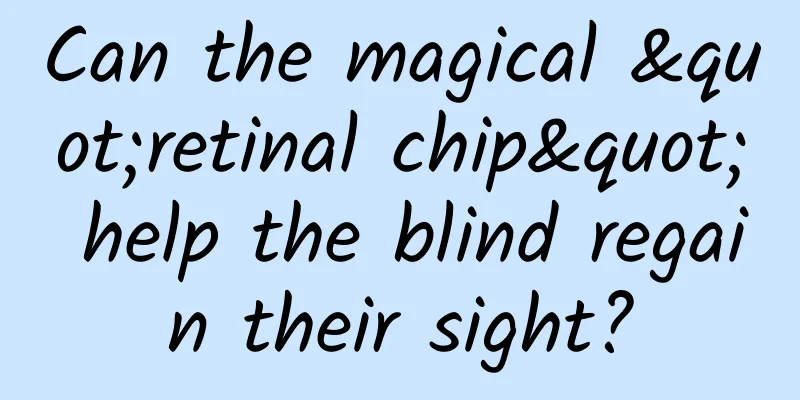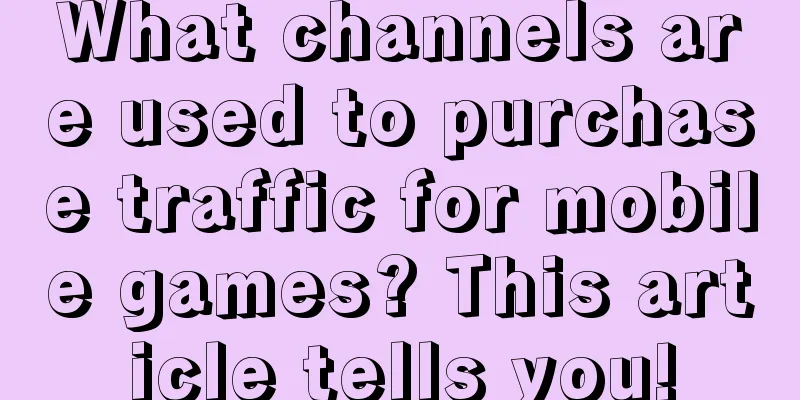Can the magical "retinal chip" help the blind regain their sight?

|
Vision is an important way for people to obtain information from the outside world, but the blind have lost their normal vision. Scientists have been trying to help the blind change their current situation. For example, many scientists have been studying something called "retinal chip". So what exactly does this retinal chip do? Is it useful? I saw such a news when I was in primary school. The TV said that some scientists had developed a device to help blind people see the world. The news also showed a blind person wearing it to avoid obstacles. A few days later, I saw it in the newspaper. The title was "Electronic eyes help blind people see again." At that time, our class had a skit about wanting to be a scientist when they grow up, and quoted this news. Coincidentally, the research direction I did when I grew up was also related to this. In fact, we often say that helping blind people "see the light again" is not so accurate. Blindness does not necessarily mean that you cannot see any light. According to the standards of the World Health Organization, if a person's better eye cannot see 0.05 no matter how much it is corrected, it is considered blind. What is the concept of 0.05? The top and largest number on the eye chart of our daily physical examination is 0.1. If it is larger than that, you can't tell which direction your mouth is facing even if you wear the most suitable glasses. In addition, if the field of vision radius is less than 10 degrees, it is also considered blind. Scientists have also thought of many different ways to improve the vision of the blind. In 1978, a scientist proposed a method called "phosphene", which directly uses an electrode array to stimulate the visual center of the brain. Because people see things with their eyes, but ultimately it is the brain that feels them. If you directly stimulate the area of the brain that senses vision, if the stimulation is just right, it can make it feel "seeing" directly. However, few people later studied this method because it is risky, requires craniotomy, and is prone to infection. And how to stimulate people to feel the corresponding feeling is very complicated. In addition to directly stimulating the brain, another method is to start from the eyes, which is what we mentioned at the beginning, called retinal chips, or retinal prostheses, or visual prostheses, which are mainly aimed at blindness caused by retinal diseases. There are already successful cases of commercial companies doing this. Everyone knows the role of the retina. The light and shadow of the outside world are formed on the retina through the eyeball. After the retina senses this image, it is transmitted to the visual center of the brain, and there is a sense of sight. In fact, the retina converts light signals into electrical signals. Because what is sensed is light signals, the nerves mainly transmit electrical signals during the transmission process to the brain. So some people imitated this principle and made retinal prostheses, that is, retinal chips. There are also two types of this principle, one is called "active" and the other is called "passive". The passive type is easier to understand. Your retina is damaged, so I make a device and put it in the human eyeball to sense light. After the sensor senses the light, it is processed by the circuit to generate an electrical stimulation signal, which stimulates the functional cells in the retina and then transmits it to the optic nerve. It is equivalent to making a device that converts light signals into electrical signals, directly replacing the function of the retina. There is also an active type, which uses a camera to capture the outside world, and then processes and encodes it and transmits it wirelessly to the retinal chip, which then passes it to the electrodes to generate current to stimulate the optic nerve. Of course, these electrodes are implanted in the eyes, so they are all flexible electrodes with particularly good biocompatibility. There used to be a brand called Argus abroad for this active type. Their second generation has 60 pixels. In some countries, they have a license to implant it. Of course, it is very expensive. The surgery costs 150,000 US dollars, but the effect is not bad. Some people say that this is a good effect? What can you see with 60 pixels? How blurry is it? How can you compare this? If you install a 60-pixel chip on a person with normal vision, he will kill you. But for patients who can basically see nothing before, now they can see 60 pixels, which is a great improvement. In addition, their company originally planned to make the third generation, which was said to be able to achieve 1,000 pixels, but because the company's operations were not good, it later merged with another company. I heard that after-sales service was difficult to guarantee. However, many people are still continuing this research, and their team leader has also come to China to conduct cooperative research with some institutions. We also hope that there will be more breakthroughs in the future. In addition to retinal chips, there is actually another device that helps the blind. It does not need to be implanted. The blind can put it in their mouth and have a sense of "seeing". Isn't it amazing? If you are interested, you can search it and take a look. I will tell you in detail when I have the chance. Either way, it helps the blind improve their lives, which is also one of the social responsibilities of scientists. This article is a work supported by Science Popularization China Starry Sky Project Author: Zhang Yuzhi Reviewer: Huang Yongguang (Associate Researcher, Institute of Semiconductors, Chinese Academy of Sciences) Produced by: China Association for Science and Technology Department of Science Popularization Producer: China Science and Technology Press Co., Ltd., Beijing Zhongke Xinghe Culture Media Co., Ltd. |
>>: Why does the world map only have 4 colors?
Recommend
18 super cool magic lessons
18 super cool magic lessons resource introduction...
How to withdraw provident fund after resigning? Conditions for withdrawing housing provident fund after resignation in Zhengzhou
How to withdraw provident fund after resigning? A...
Can a tempered glass screen protect your phone? Is a screen protector a waste of money?
Recently, #手机贴膜智商税# has become a hot search, spar...
Does eating burnt food increase the risk of cancer? Developing these five cooking habits can save your life
This article was reviewed by Pa Li Ze, chief phys...
ASO optimization, some things you have to know when doing ASO!
1. The world is in dispute, and CPs discuss ranki...
Why did Emperor Wen of Han want to be alone in Bailuyuan?
On the morning of December 14, the State Administ...
I want to travel - the seeds are crazy
When you were a kid, did you also dream about tra...
Dual-core noise reduction, lightweight, Sony WH-1000XM5 sets a new benchmark for noise reduction
In an era when true wireless headphones have beco...
VideoStudio 2020 video tutorials from beginner to advanced
Suitable for people: Beginners who want to system...
We are both doing ocpc, why is yours not producing enough volume and has no effect?
Optimizing oCPC is a challenge that must be faced...
Xiaohongshu store operation, delivery and promotion
At the beginning of 2022, Xiaohongshu's commu...
April's "Science" Rumors: Will storing CO2 at sea affect the ecology? Is fat the cause of bloating?
The list of "scientific" rumors for Apr...
Battlefield 1 PS4 Edition Review: A Dream Return to the First World War: Old Soldiers Remain Undead and Pick Up Guns Again
In the golden month of October, Battlefield 1 was...
Exposed! Are “food scraps” cheap and delicious? The truth is…
Recently, the term "food scraps" has gr...
Do animals grieve when their companions die?
In 2000, Karen McComb and others placed an elepha...









